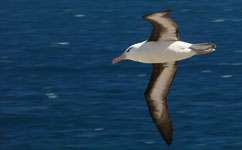Black-browed albatross.
(Phys.org) —A new model can predict the location of the most important fishing grounds for the black-browed albatross, helping conservationists to protect this endangered species.
Albatrosses are one of our most iconic, yet most threatened birds, with 19 out of 22 species at risk of extinction. Tens of thousands are lured to their deaths each year as they scavenge behind fishing fleets.
Attracted by the tempting meal of fish offal and discards, they end up swallowing the baited hooks trailed behind long-line boats, or colliding with trawler cables and breaking their wings.
But if we can predict where the birds are likely to be fishing at different times of year, simple precautions such as temporary fishing exclusions or bans on discarding fish waste could reduce these deaths.
'We need to know where the birds are foraging, if we want to create marine protected areas,' explains Paulo Catry from the Eco-ethology Research Unit at ISPA in Lisbon, who led the study.
But albatrosses range widely in search of food, flying up to 1000 kilometres in a single day. Outside the breeding season, they have even been known to circumnavigate the globe, soaring on a wingspan of two to three metres.
Scientists can track individual birds by attaching GPS loggers, but this has its limits. 'The problem is that birds from different colonies go to different places,' says Catry, 'and you can't track birds from every single colony.'
The foraging areas can also change from year to year, as ocean conditions vary. To tackle this problem, the international research team developed a new computer model to try to predict where the birds fish during the breeding season.
They checked the results of the model by tracking 99 black-browed albatrosses from two different colonies west of the Falkland Islands, over two years. Each bird was fitted with a GPS logger and a tiny device called an immersion-geolocator, developed at the British Antarctic Survey. These record natural light levels and wet-dry transitions, to show when and where the birds land on the sea to feed.
The model produced a map predicting the best fishing areas, based on sea surface temperature, ocean depth, phytoplankton concentrations – higher in food-rich areas, distance from the nest sites, wind speed and direction, competition from other albatross colonies, and the location of fishing fleets.
The map agreed well with the tracking results, both of which show that the birds prefer to feed in shallow seas, especially near underwater slopes where upwelling currents bring prey close to the surface. Because of the need to return to the nest regularly to feed the chicks, distance from the nest site is critical, as is wind direction – albatrosses like to fly in crosswinds, avoiding tailwinds and headwinds.
Reducing discards could avoid albatross deaths
Birds from the two colonies, which are 75 kilometres apart, largely avoid trespassing into their neighbour's territory. Although both colonies range throughout the south Patagonian Sea, up to 500 kilometres from their breeding sites, their main feeding areas are concentrated within 50 kilometres of the colonies and do not overlap.
Interestingly, these areas are roughly similar in size, even though the Steeple Jason colony is 15 times larger than the New Island colony – apparently disproving the theory that birds from larger colonies have to travel further to find food.
Surprisingly, although fishing fleets are known to attract hordes of scavenging albatrosses, the tracked birds spent little time feeding around the boats, which were operating around 100 kilometres from the colonies. This suggests that the birds do not go out of their way to find and follow fishing fleets.
'The albatross can live happily without having to get food from the fishing vessels, because only a small minority of their needs are being covered there,' explains Catry.
This shows that reducing the amount of discards could help to avoid albatross deaths, without affecting their food supply.
Another surprise was the variation between the two years of the study. In the first year, birds from the New Island colony fed mostly quite close to home, but in the second year they foraged much further afield, with many more visits to Staten island, off the coast of Tierra del Fuego, some 500 kilometres away. The model successfully predicted this difference, based on changes in the sea surface temperature, phytoplankton concentrations and wind between the two years. In the future, the model could be adapted to look at other seabirds or even marine mammals.
The main foraging areas for both colonies lie in the rich, shallow seas to the west of the Falkland Islands, which are a spawning ground for sprat, southern blue whiting and red cod, as well as being an important feeding area for fur seals, penguins and other seabirds.
'It would be really good to have a marine protected area in this extremely important region,' says Catry, 'but we need a more complete analysis, looking at other species and at social and economic factors. We are trying to complete the picture by collaborating with other researchers to gather knowledge that could allow the creation of a marine protected area somewhere in the West Falklands.'
More information: Catry, P. et al. Predicting the distribution of a threatened albatross: The importance of competition, fisheries and annual variability. Progress in Oceanography, published online 1 February 2013.
Provided by PlanetEarth Online
This story is republished courtesy of Planet Earth online, a free, companion website to the award-winning magazine Planet Earth published and funded by the Natural Environment Research Council (NERC).






















